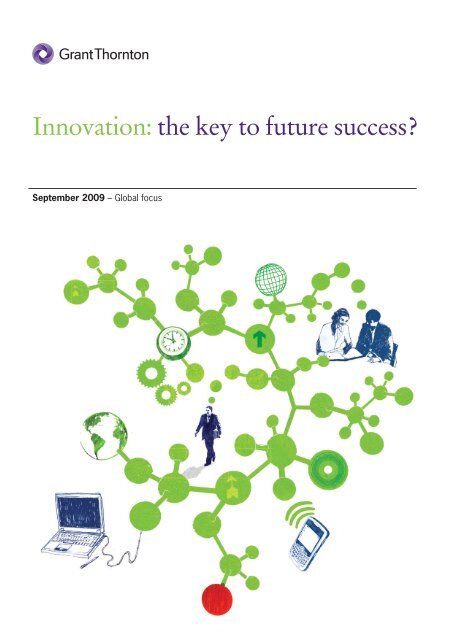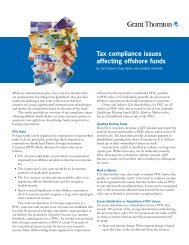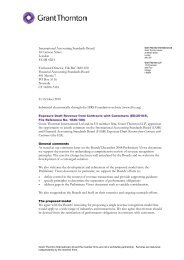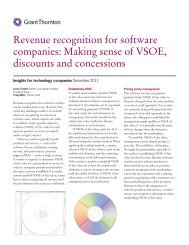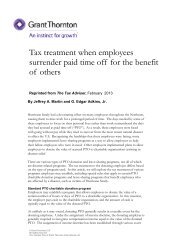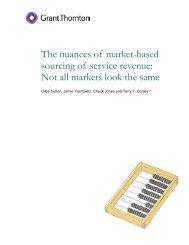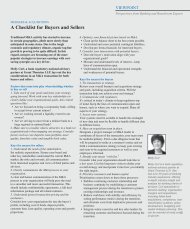Innovation: the key to future success - Global focus - Grant Thornton
Innovation: the key to future success - Global focus - Grant Thornton
Innovation: the key to future success - Global focus - Grant Thornton
Create successful ePaper yourself
Turn your PDF publications into a flip-book with our unique Google optimized e-Paper software.
<strong>Innovation</strong>: <strong>the</strong> <strong>key</strong> <strong>to</strong> <strong>future</strong> <strong>success</strong>?<br />
September 2009 – <strong>Global</strong> <strong>focus</strong>
About <strong>the</strong> report<br />
This report, produced by <strong>Grant</strong> Thorn<strong>to</strong>n, examines <strong>the</strong> thoughts and<br />
attitudes of business executives globally <strong>to</strong>wards innovation. A survey<br />
conducted by <strong>the</strong> Economist Intelligence Unit (EIU) is combined with<br />
insight from <strong>Grant</strong> Thorn<strong>to</strong>n specialists from around <strong>the</strong> international<br />
organisation. This report forms part of a series of regional reports with<br />
o<strong>the</strong>r regions covered being Western Europe, North America and Asia<br />
Pacific.<br />
Contents<br />
00 About <strong>the</strong> report<br />
01 Executive summary<br />
02 The innovative environment<br />
06 Reasoning<br />
08 Calls <strong>to</strong> action<br />
10 Conclusion<br />
12 <strong>Grant</strong> Thorn<strong>to</strong>n International worldwide
Executive summary<br />
With economies around <strong>the</strong> world in <strong>the</strong> grip of <strong>the</strong> worst recession<br />
since <strong>the</strong> Second World War, <strong>the</strong> <strong>focus</strong> of many in <strong>the</strong> business<br />
community has turned <strong>to</strong>wards innovation. Things have gone badly<br />
wrong, so what must we do differently, what must we try that<br />
is new <strong>to</strong> help stimulate growth for sustained recovery? To put a more<br />
positive spin on <strong>the</strong> situation, what kinds of innovation will best help<br />
us <strong>to</strong> emerge from recession stronger than we went in, <strong>to</strong> gain market<br />
share, or <strong>to</strong> thrive in new and exciting markets?<br />
This report helps <strong>to</strong> answer many of <strong>the</strong>se<br />
questions, through its rigorous survey of several<br />
hundred high level executives from <strong>the</strong> three major<br />
trading regions of <strong>the</strong> world.<br />
In Asia Pacific, we find that cus<strong>to</strong>mer <strong>focus</strong><br />
is a tremendous source of innovative ideas and<br />
products, with 47 per cent of respondents noting<br />
<strong>the</strong> increased impact of cus<strong>to</strong>mers on innovation<br />
processes, compared with 39 per cent in North<br />
America and 38 per cent in Western Europe.<br />
<strong>Innovation</strong> in general is regarded as a <strong>to</strong>p<br />
corporate priority by more executives in Western<br />
Europe (41 per cent) than in North America<br />
(33 per cent) or in Asia Pacific (31 per cent), and its<br />
respondents design more innovations for <strong>the</strong> global<br />
market (60 per cent) than its counterparts in North<br />
America (46 per cent) or Asia Pacific (47 per cent).<br />
North America remains <strong>the</strong> best region for<br />
innovation overall, according <strong>to</strong> all respondents,<br />
with <strong>the</strong> United States achieving an average score<br />
of 77 per cent as <strong>the</strong> place where it is easiest <strong>to</strong><br />
create innovative products, services and business<br />
models. The region scores less well in its cus<strong>to</strong>mer<br />
relations; and its respondents are more likely <strong>to</strong> cut<br />
investment in innovation until <strong>the</strong> market picks<br />
up than those in o<strong>the</strong>r regions.<br />
<strong>Innovation</strong>: <strong>Global</strong> <strong>focus</strong> 1
The innovative environ<br />
The role of cus<strong>to</strong>mers, along with <strong>the</strong> attitude of companies <strong>to</strong> <strong>the</strong>ir<br />
cus<strong>to</strong>mers, emerges as a defining characteristic in <strong>the</strong> survey. No longer<br />
simply passive recipients of goods and services, cus<strong>to</strong>mers now help <strong>to</strong><br />
shape <strong>the</strong> <strong>future</strong> of <strong>the</strong>ir own consumption. They are now <strong>the</strong> leading<br />
source of innovations globally (41 per cent), more important than anything<br />
inside companies, including research and development (see figure 1).<br />
Firms in Asia Pacific are particularly attuned <strong>to</strong><br />
what <strong>the</strong>ir cus<strong>to</strong>mers want with almost half (48 per<br />
cent) of <strong>the</strong> best innovative ideas coming from<br />
cus<strong>to</strong>mers against 40 per cent in Western Europe<br />
and 35 per cent in North America. <strong>Global</strong>ly, heads<br />
of business units followed as <strong>the</strong> best origins of<br />
ideas followed by general employees and <strong>the</strong> inhouse<br />
R&D team (both 33 per cent).<br />
2 <strong>Innovation</strong>: <strong>Global</strong> <strong>focus</strong>
ment<br />
Figure 1: Origin of <strong>the</strong> best innovation ideas<br />
Average percentage of businesses<br />
Cus<strong>to</strong>mers<br />
Heads of business units<br />
General employees<br />
In-house R&D team<br />
CEO<br />
Business partners and suppliers<br />
O<strong>the</strong>r C-level employees<br />
Sales<br />
Special innovation team<br />
Outsourced R&D team<br />
O<strong>the</strong>r<br />
41<br />
48<br />
35<br />
40<br />
35<br />
43<br />
35<br />
28<br />
33<br />
31<br />
33<br />
34<br />
33<br />
30<br />
34<br />
34<br />
27<br />
24<br />
28<br />
28<br />
26<br />
31<br />
21<br />
28<br />
22<br />
20<br />
22<br />
23<br />
17<br />
17<br />
13<br />
22<br />
16<br />
16<br />
17<br />
13<br />
7<br />
6<br />
8<br />
8<br />
5<br />
6<br />
6<br />
4<br />
<strong>Global</strong> Asia Pacific North America Western Europe<br />
Source: <strong>Grant</strong> Thorn<strong>to</strong>n/EIU<br />
<strong>Innovation</strong>: <strong>Global</strong> <strong>focus</strong> 3
Figure 2: What is your organisation’s stance on ‘open innovation’, in which companies leverage both internal and external sources of ideas?<br />
Average percentage of businesses<br />
Have <strong>success</strong>fully applied it and will continue<br />
<strong>to</strong> do so<br />
Have never heard of it<br />
Never considered it – our own intellectual property<br />
is <strong>to</strong>o valuable <strong>to</strong> share<br />
Explored <strong>the</strong> concept but can’t benefit from it<br />
Explored <strong>the</strong> concept but it is <strong>to</strong>o complicated<br />
or expensive for us <strong>to</strong> adopt<br />
Appointed internal specialists <strong>to</strong> work on open<br />
innovation strategy<br />
Applied it in <strong>the</strong> past without <strong>success</strong> and will<br />
not consider again<br />
33<br />
34<br />
30<br />
35<br />
16<br />
15<br />
19<br />
14<br />
14<br />
11<br />
14<br />
17<br />
13<br />
11<br />
14<br />
14<br />
11<br />
13<br />
9<br />
10<br />
8<br />
8<br />
8<br />
8<br />
6<br />
8<br />
5<br />
4<br />
<strong>Global</strong> Asia Pacific North America Western Europe<br />
Source: <strong>Grant</strong> Thorn<strong>to</strong>n/EIU<br />
<strong>Global</strong>ly, respondents believe that open<br />
innovation – where ideas and information are<br />
shared with a third party – is <strong>key</strong> <strong>to</strong> <strong>future</strong> growth<br />
with 33 per cent having applied open innovation<br />
and will continue <strong>to</strong> do so. This figure is lowest in<br />
North America (30 per cent) and highest in Western<br />
Europe (35 per cent), see figure 2. Respondents in<br />
Asia Pacific are less concerned than <strong>the</strong>ir peers<br />
elsewhere with protecting <strong>the</strong>ir intellectual<br />
property (11 per cent) compared <strong>to</strong> those in<br />
Western Europe (17 per cent).<br />
North American firms appear surprisingly<br />
inward looking when describing <strong>the</strong>ir policy<br />
<strong>to</strong>wards inventing an innovation over <strong>the</strong> next<br />
two years with just 49 per cent of respondents<br />
citing innovation as a means <strong>to</strong> explore new<br />
markets. This compares <strong>to</strong> 63 per cent in Western<br />
Europe and 63 per cent in Asia Pacific, see figure 3.<br />
<strong>Global</strong>ly, <strong>the</strong> second most popular policy for<br />
innovation is <strong>to</strong> minimise risk in a <strong>to</strong>ugher market<br />
(56 per cent). This was most common in Western<br />
European responses (58 per cent) and least common<br />
in both Asia Pacific and North America (both<br />
52 per cent).<br />
4 <strong>Innovation</strong>: <strong>Global</strong> <strong>focus</strong>
Figure 3: What best describes your company’s policy <strong>to</strong>wards investing in innovation over <strong>the</strong> next two years?<br />
Average percentage of businesses<br />
Developing new products/services, or redesign<br />
existing ones, so we can find new markets for <strong>the</strong>m<br />
Investing more on developing new innovations <strong>to</strong><br />
minimise our risk in a <strong>to</strong>ugher market<br />
Investing in technology <strong>to</strong> better develop<br />
products/services<br />
Engaging in co-creation with stakeholders<br />
Planning <strong>to</strong> merge with or acquire ano<strong>the</strong>r<br />
company <strong>to</strong> make use of its innovations<br />
Hiring staff dedicated <strong>to</strong> new product and<br />
service development<br />
Cutting back our spending on developing new<br />
innovations until <strong>the</strong> market picks up<br />
Outsourcing our innovation programmes<br />
56<br />
60<br />
49<br />
63<br />
54<br />
52<br />
52<br />
58<br />
48<br />
53<br />
44<br />
49<br />
23<br />
25<br />
20<br />
23<br />
17<br />
20<br />
19<br />
13<br />
16<br />
16<br />
14<br />
17<br />
13<br />
10<br />
18<br />
10<br />
8<br />
13<br />
7<br />
5<br />
<strong>Global</strong> Asia Pacific North America Western Europe<br />
Source: <strong>Grant</strong> Thorn<strong>to</strong>n/EIU<br />
“Companies may want <strong>to</strong> re-visit <strong>the</strong>ir globalisation strategies as<br />
a result of higher transportation costs (ie oil prices). Understanding<br />
and predicting <strong>the</strong>se trends will be critical <strong>to</strong> <strong>future</strong> investment<br />
decisions.”<br />
Jim Menzies<br />
<strong>Grant</strong> Thorn<strong>to</strong>n, Canada<br />
<strong>Innovation</strong>: <strong>Global</strong> <strong>focus</strong> 5
Based on in-depth interviews with our specialists around <strong>the</strong> world, we<br />
have ga<strong>the</strong>red additional evidence for <strong>the</strong> trends we have detected in<br />
corporate innovation.<br />
In <strong>the</strong> Asia Pacific region, cus<strong>to</strong>mers are highly<br />
valued for <strong>the</strong>ir input in<strong>to</strong> innovation processes, as<br />
companies strive <strong>to</strong> find products with mass appeal.<br />
Countries such as Japan, with a long his<strong>to</strong>ry of<br />
incremental technical innovation, are able <strong>to</strong> react<br />
quickly <strong>to</strong> new developments and bring new<br />
products <strong>to</strong> market.<br />
An open approach <strong>to</strong> innovation is popular in<br />
<strong>the</strong> region, with joint ventures and partnerships<br />
thriving in <strong>the</strong> current economic climate. But <strong>the</strong>re<br />
remain concerns over <strong>the</strong> protection of intellectual<br />
property and legal enforcement of rights. Western<br />
companies are encouraged <strong>to</strong> locate research and<br />
development operations in Asia Pacific, <strong>to</strong> benefit<br />
from low costs and <strong>to</strong> improve intellectual property<br />
protection.<br />
In some parts of <strong>the</strong> Asia Pacific region, political<br />
instability can threaten <strong>the</strong> progress of innovation,<br />
as firms are unable <strong>to</strong> predict <strong>the</strong> way that laws and<br />
regulations will be administered in <strong>future</strong>.<br />
In Western Europe, <strong>the</strong>re is a rising level of<br />
risk-aversion during <strong>the</strong> economic recession, with<br />
firms and governments (such as France) aiming <strong>to</strong><br />
draw back investment from emerging economies<br />
in<strong>to</strong> <strong>the</strong> region. Support for domestic companies<br />
that are developing innovative new technology is<br />
increasing, however.<br />
“Eventually, a competi<strong>to</strong>r will innovate and<br />
become <strong>the</strong> new bellwe<strong>the</strong>r. Staying ahead of<br />
<strong>the</strong> competition is <strong>the</strong> best reason of all <strong>to</strong><br />
innovate.”<br />
Harris Smith<br />
<strong>Grant</strong> Thorn<strong>to</strong>n, United States<br />
6 <strong>Innovation</strong>: <strong>Global</strong> <strong>focus</strong>
“In Sweden, everyone is permitted <strong>to</strong> play a role in developing new<br />
ideas, from blue collar staff through <strong>to</strong> management. Sweden has a<br />
population of nine million, a highly educated workforce, good<br />
infrastructure and a high percentage of internet use.”<br />
Pär Ekengren<br />
<strong>Grant</strong> Thorn<strong>to</strong>n, Sweden<br />
In <strong>the</strong> Nor<strong>the</strong>rn European region of<br />
Scandinavia, innovation – particularly in high<br />
technology – is valued and well supported by<br />
government. Countries such as Sweden were quick<br />
<strong>to</strong> embrace <strong>the</strong> IT revolution and now offer many<br />
products designed for <strong>the</strong> global market. Western<br />
Europe as a whole is generally outward looking and<br />
keen <strong>to</strong> offer products and services <strong>to</strong> <strong>the</strong> global<br />
market.<br />
The long-standing tradition of competition<br />
between companies in North America will ensure<br />
that any sense of inertia or complacency will be<br />
short-lived, as innovative rivals emerge. Government<br />
support has returned in some crucial sec<strong>to</strong>rs, such<br />
as clean tech and pharmaceuticals after a period of<br />
faltering support during <strong>the</strong> Bush administration.<br />
Never<strong>the</strong>less, <strong>the</strong> balance between investing in<br />
innovation and retrenching until better times return<br />
has <strong>to</strong> be finely judged, as many firms struggle <strong>to</strong><br />
survive. North American firms are unusually riskaverse<br />
in current conditions.<br />
In Canada, generous government support has<br />
failed <strong>to</strong> create an innovative culture, since natural<br />
resources have led <strong>to</strong> a conservative approach <strong>to</strong><br />
business. The threat of climate change and energy<br />
issues may spur <strong>future</strong> innovation.<br />
<strong>Innovation</strong>: <strong>Global</strong> <strong>focus</strong> 7
Calls <strong>to</strong> act<br />
ion<br />
Companies around <strong>the</strong> world may wish <strong>to</strong> consider <strong>the</strong> following<br />
points:<br />
• pay more attention <strong>to</strong> what your cus<strong>to</strong>mers say and <strong>the</strong>ir ideas for<br />
innovations<br />
• consider expanding your open innovation projects and working<br />
with more third parties<br />
• look outwards, explore new markets, ra<strong>the</strong>r than drawing back<br />
in<strong>to</strong> your domestic market<br />
• capitalise on <strong>the</strong> great shifts of <strong>the</strong> age, <strong>the</strong> move away from<br />
carbon-based energy and <strong>the</strong> emergence of China and India as<br />
major trading nations with huge consumer markets.<br />
“In <strong>the</strong> French au<strong>to</strong>motive, aerospace and cosmetics industries,<br />
<strong>the</strong>re is no profit without innovation, so conditions are ideal. But in<br />
<strong>the</strong> country as a whole, research and development isn’t sufficiently<br />
recognised. Researchers at Universities are poorly paid and many<br />
leave <strong>to</strong> work in <strong>the</strong> UK, Canada or US.”<br />
Frédéric Zei<strong>to</strong>un<br />
<strong>Grant</strong> Thorn<strong>to</strong>n, France<br />
8 <strong>Innovation</strong>: <strong>Global</strong> <strong>focus</strong>
“You have <strong>to</strong> be able <strong>to</strong> see<br />
that <strong>the</strong>re is a <strong>future</strong> for your<br />
investment. Governments<br />
need <strong>to</strong> show <strong>the</strong>y are willing<br />
<strong>to</strong> support you.”<br />
Desmond Yuen<br />
<strong>Grant</strong> Thorn<strong>to</strong>n, Hong Kong<br />
<strong>Innovation</strong>: <strong>Global</strong> <strong>focus</strong> 9
Conclusion<br />
10 <strong>Innovation</strong>: <strong>Global</strong> <strong>focus</strong>
As with any major disruption, especially one such as <strong>the</strong> global credit<br />
crunch and continued economic uncertainty, affecting billions of<br />
consumers and millions of businesses, predicting likely outcomes is<br />
fraught with danger. Economies that were small and struggling just a<br />
few years ago may return <strong>to</strong> <strong>the</strong>ir troubled earlier state, or <strong>the</strong>y may<br />
emerge from <strong>the</strong> recession with an extraordinary new vitality. Well<br />
established mature economies may suffer just a minor inconvenient<br />
period of lower growth before returning <strong>to</strong> rude health, or <strong>the</strong>y may<br />
fail <strong>to</strong> recover for decades.<br />
What this report demonstrates is <strong>the</strong> extent <strong>to</strong><br />
which globalisation has changed corporate<br />
priorities. Whereas companies operating in <strong>the</strong><br />
1980s and 1990s may have viewed <strong>the</strong> Far East as a<br />
source of cheap labour and manufacturing resource,<br />
<strong>to</strong>day it is a vast and growing market for <strong>the</strong>ir own<br />
products and services, a place where alliances and<br />
partnerships of equals have replaced client and<br />
supplier relationships.<br />
<strong>Innovation</strong> is no longer a practice confined <strong>to</strong><br />
<strong>the</strong> labora<strong>to</strong>ries of North America and Western<br />
Europe, but a word rich in meaning for <strong>the</strong> supply<br />
chain professionals of Shanghai, <strong>the</strong> IT direc<strong>to</strong>rs of<br />
S<strong>to</strong>ckholm and <strong>the</strong> product designers of Seattle.<br />
The interwoven strands of open innovation,<br />
outward-looking attitudes, collaborative working<br />
practices and <strong>the</strong> desire <strong>to</strong> cater <strong>to</strong> new,<br />
international markets have created a tapestry<br />
of mutual reliance.<br />
We hope this report will help you <strong>to</strong> appreciate<br />
<strong>the</strong>se new realities and <strong>to</strong> incorporate <strong>the</strong> best<br />
innovative practices in<strong>to</strong> your business life.<br />
“Products have an extremely short life cycle, so<br />
incremental innovation is always critical.”<br />
Hiroyuki Hamamura<br />
<strong>Grant</strong> Thorn<strong>to</strong>n, Japan<br />
<strong>Innovation</strong>: <strong>Global</strong> <strong>focus</strong> 11
<strong>Grant</strong> Thorn<strong>to</strong>n International<br />
firms worldwide<br />
This list represents <strong>the</strong> countries and terri<strong>to</strong>ries<br />
where <strong>Grant</strong> Thorn<strong>to</strong>n International member and<br />
correspondent* firms currently have operations.<br />
July 2009.<br />
*for a detailed explanation of <strong>the</strong> differences between<br />
correspondent and member firms please visit www.gti.org<br />
Antilles*<br />
Argentina<br />
Armenia<br />
Australia<br />
Austria<br />
Bahamas<br />
Bahrain<br />
Belgium<br />
Bermuda*<br />
Bolivia<br />
Botswana<br />
Brazil<br />
Bulgaria<br />
Cambodia<br />
Canada<br />
Cayman Islands<br />
Channel Islands<br />
Chile<br />
China<br />
Colombia<br />
Costa Rica<br />
Croatia<br />
Cyprus<br />
Czech Republic<br />
Denmark<br />
Dominican Republic<br />
Egypt<br />
El Salvador<br />
Finland<br />
France<br />
Gabon*<br />
Germany<br />
Ghana*<br />
Gibraltar<br />
Greece<br />
Guam<br />
Guatemala<br />
Guyana*<br />
Honduras<br />
Hong Kong<br />
Hungary<br />
Iceland<br />
India<br />
Indonesia<br />
Iran*<br />
Ireland<br />
Isle of Man<br />
Israel<br />
Italy<br />
Jamaica<br />
Japan<br />
Jordan<br />
Kenya<br />
Korea<br />
Kosovo<br />
Kuwait<br />
Latvia*<br />
Lebanon<br />
Liechtenstein*<br />
Luxembourg<br />
Macedonia<br />
Malaysia<br />
Malta<br />
Mauritius<br />
Mexico<br />
Morocco<br />
Mozambique<br />
Namibia<br />
Ne<strong>the</strong>rlands<br />
New Zealand<br />
Nicaragua<br />
Nigeria*<br />
Norway<br />
Oman<br />
Pakistan<br />
Panama<br />
Philippines<br />
Poland<br />
Portugal<br />
Puer<strong>to</strong> Rico<br />
Qatar<br />
Romania*<br />
Russia<br />
Saudi Arabia<br />
Serbia*<br />
Singapore<br />
Slovak Republic<br />
Slovenia<br />
South Africa<br />
Spain<br />
Sri Lanka*<br />
Sweden<br />
Switzerland<br />
Taiwan<br />
Thailand<br />
Tunisia<br />
Tur<strong>key</strong><br />
Turks and Caicos*<br />
Uganda<br />
Ukraine<br />
United Arab Emirates<br />
United Kingdom<br />
United States<br />
Uruguay<br />
Venezuela<br />
Vietnam<br />
Yemen<br />
Zambia<br />
12 <strong>Innovation</strong>: <strong>Global</strong> <strong>focus</strong>
Fur<strong>the</strong>r reading<br />
<strong>Innovation</strong> Island: Is <strong>the</strong> UK open for business? – April 2009<br />
Available <strong>to</strong> download from: www.grant-thorn<strong>to</strong>n.co.uk/innovation<br />
<strong>Innovation</strong> Engine: Extracting value from ideas – June 2009<br />
Available <strong>to</strong> download from: www.grant-thorn<strong>to</strong>n.co.uk/innovation<br />
Natural Born Innova<strong>to</strong>rs: What connects UK entrepreneurs with<br />
<strong>success</strong>? – July 2009<br />
Available <strong>to</strong> download from: www.grant-thorn<strong>to</strong>n.co.uk/innovation<br />
Also in this series<br />
Available <strong>to</strong> download from: www.gti.org/publications<br />
Asia Pacific North America Western Europe
www.gti.org<br />
© 2009 <strong>Grant</strong> Thorn<strong>to</strong>n International Ltd. All rights reserved.<br />
<strong>Grant</strong> Thorn<strong>to</strong>n International Ltd (<strong>Grant</strong> Thorn<strong>to</strong>n International) and<br />
<strong>the</strong> member firms are not a worldwide partnership. Services are<br />
delivered independently by <strong>the</strong> member firms.


